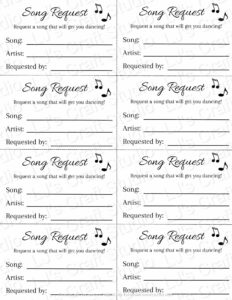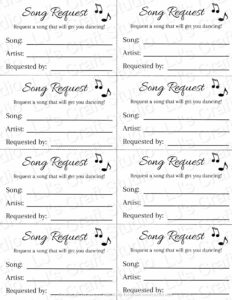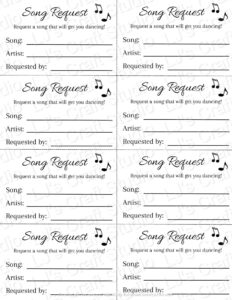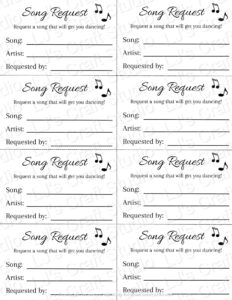Organized requests facilitate smoother event flow and enhance the overall experience for everyone involved. For requesters, it provides a clear and easy method for submitting their preferences. For DJs, it allows for efficient management of incoming requests, reducing confusion and enabling them to focus on their performance. Ultimately, this contributes to a more enjoyable and organized atmosphere.
Understanding the components and best practices for structuring these submissions is crucial for both attendees and event organizers. The following sections will delve into specific examples and elaborate on the practical application of these principles in various settings.
Key Components of a Music Request Format
Effective music requests hinge on providing essential information in a clear and concise manner. This section details the key components of a well-structured request.
1: Song Title: Accurate and complete song titles are crucial for proper identification. Providing this information minimizes ambiguity and ensures the DJ selects the correct track.
2: Artist Name: Specifying the artist prevents confusion when multiple artists share the same song title. Accurate artist information is essential for effective song retrieval.
3: Requester Name (Optional): While optional, providing a name allows for personalized announcements and acknowledgements by the DJ.
4: Special Instructions/Dedications (Optional): This field allows requesters to specify any dedications or special instructions, such as preferred versions or timing requests, enhancing the personal touch.
5: Contact Information (Optional, primarily for large events or online requests): Providing an email address or phone number can be helpful for follow-up communication regarding the request status, particularly in scenarios where clarification is required.
6: Event/Occasion (If applicable): Specifying the event or occasion, especially for private functions, provides context for the DJ and helps tailor their music selection.
Providing comprehensive information, including title, artist, and any special requests, streamlines the process, ensures accuracy, and contributes to a seamless musical experience.
How to Create a DJ Song Request Format Template
Creating a standardized template ensures consistent and efficient music request submissions. This section outlines the process of developing a practical template.
1: Determine the Input Method: Establish whether requests will be submitted physically (e.g., paper slips) or digitally (e.g., online forms, email). The chosen method dictates the template’s structure and fields.
2: Essential Fields: Include fields for the song title and artist name. These are fundamental components for accurate song identification.
3: Optional Fields: Consider incorporating optional fields for requester names, dedications, special instructions, contact information, and event/occasion. These fields enhance personalization and communication.
4: Clear Labeling: Utilize clear and concise labels for each field to ensure ease of understanding and proper completion by requesters.
5: Design and Layout: Optimize the template’s layout for readability and ease of use. Ensure ample space for writing or typing, depending on the chosen input method.
6: Testing and Refinement: Before widespread implementation, test the template with a small group to identify any potential areas for improvement or clarification.
7: Distribution and Communication: Clearly communicate the template’s availability and usage instructions to potential requesters. Provide accessible locations for physical copies or readily available links to online forms.
A well-designed template streamlines music requests, minimizing confusion and maximizing the efficiency of music selection during events. This systematic approach benefits both requesters and DJs, contributing to a seamless and enjoyable experience.
Standardized structures for music requests offer significant advantages in various settings, from weddings and parties to corporate events and radio shows. Implementing a clear format ensures efficient communication between requesters and disc jockeys, minimizing errors and enhancing the overall musical experience. Key elements such as song title, artist, and optional fields for dedications or special instructions contribute to a streamlined process. Careful consideration of input methods, clear labeling, and user-friendly design further optimize the effectiveness of these templates.
Adopting a well-defined music request process reflects a commitment to organization and professionalism, ultimately contributing to a more enjoyable and seamless event for all participants. This structured approach empowers both individuals submitting requests and those responsible for fulfilling them, fostering a positive and collaborative environment. Continued refinement and adaptation of these templates based on specific event needs will further enhance their utility and contribute to the ongoing evolution of music request management.



